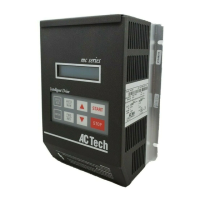32
14.0 CONTROL WIRING
14.1 GENERAL
14.1.1 KEYPAD CONTROL
The drive can be controlled by the keypad or by control devices wired to the
terminal strip. The drive will run from the keypad “out of the box”, requiring no
connections to the terminal strip. Refer to Section 13.0 - KEYPAD CONTROL.
14.1.2 CONTROL WIRING VS. POWER WIRING
External control wiring MUST be run in a separate conduit away from all other
input and output power wiring. If control wiring is not kept separate from power
wiring, electrical noise may be generated on the control wiring that will cause
erratic drive behavior. Use twisted wires or shielded cable grounded at the drive
chassis ONLY. Recommended control wire is Belden 8760 (2-wire) or 8770 (3-
wire), or equivalent.
Be careful not to overtorque the control terminals, as this will cause damage to
the terminal strip. This is not covered under warranty and can only be repaired
by replacing the control board.
14.1.3 TB-2: CIRCUIT COMMON
The TB-2 terminals are used as circuit common for the start/stop, forward/reverse,
input select, local/remote, analog input, and analog output functions. There are
three TB-2 terminals available on the terminal strip, and they are all internally
connected to each other on the main control board. If necessary TB-2 may be
connected to chassis ground.
NOTE: TB-2 MUST be connected to chassis ground when using serial
communications.
14.1.4 SURGE SUPPRESSION ON RELAYS
Current and voltage surges and spikes in the coils of contactors, relays, solenoids,
etc, near or connected to the drive, can cause erratic drive operation. Therefore,
a snubber circuit should be used on coils associated with the drive. For AC coils,
snubbers should consist of a resistor and a capacitor in series across the coil. For
DC coils, a free-wheeling or flyback diode should be placed across the coil.
Snubbers are typically available from the manufacturer of the device.

